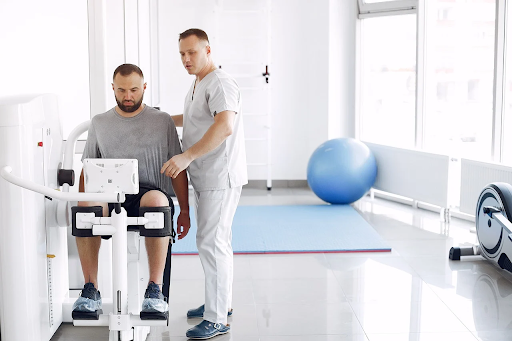Every step we take, every breath we make, exercise unfurls a tapestry of health benefits that science has long championed. But for survivors of brain injury, that next step can be a labyrinth, with the fear of tangling in unforeseen risks and challenges. This post isn’t just about movement; it’s a guide through the mazes of post-brain injury exercise, weaving a narrative of recovery, resilience, and route — the safe route to a fitter, more vibrant life.
The Endless Benefits and The Initial Hurdle
In the aftermath of brain trauma, the ground beneath your feet is an intricate puzzle, and balance teeters on certainty’s edge. Yet there is beauty in paradoxes, as here is where exercise’s solitary promise begins to illuminate the path ahead.
Movement’s Medicine: The Unseen Benefits
Exercise for brain injury survivors goes beyond physical rebuilding; it’s mental fortification. It enhances neuroplasticity, improving cognitive function and emotional well-being. Starting slowly and with physician approval, the right routine reduces depression and anxiety, boosts self-esteem, and fosters independence. The key is a personalized, gradual progression, ensuring safety while harnessing the exercise’s healing power.
Balancing Act: Navigating Initial Risks and Doubts
The fear of the unknown, of potential damage, lingers as cloud cover in the survivors’ sky. Understanding and acknowledging these trepidations are the first vital steps toward unearthing a routine that balances safety with rejuvenation. For survivors stepping back into exercise, consultation with professionals is crucial. On the legal aspect, Alpharetta brain injury attorneys recommend this step. Like doctors, brain injury attorneys can help plan and restructure your life. These attorneys not only offer legal advice post-injury but can guide on the rights and resources available for a safer, structured rehabilitation pathway. This step ensures that your return to physical activity is information-guided and protected, paving a clearer, more secure route toward recovery.
Understanding The Varied Landscape of Brain Injuries
No two injuries are the same, and herein lies the challenge. Brain injury is a spectrum, with concussions at one end, leading to more severe conditions on the other. Each survivor charts a personal topography of recovery.
A Spectrum Unfolded: The Many Faces of Brain Injury
Brain injuries range from mild concussions to severe trauma, affecting individuals uniquely. Recovery paths vary, influenced by the injury’s severity, location, and the individual’s overall health. Acknowledging this spectrum is crucial in tailoring rehabilitation efforts, recognizing that each case demands a personalized approach to exercise, therapy, and support. Furthermore, recognizing where you are on this spectrum is the key to unlocking an exercise regimen that is both custom-fit and effective.
Consult and Construct: Building a Plan with Health Professionals
The first architect of your exercise plan should be your healthcare provider. This collaboration allows for a tailored approach that considers unique challenges. Medical specialists, therapists, and trainers skilled in brain injury rehabilitation can offer insights that ensure activities promote healing without risking further harm. Their guidance helps construct a blueprint for exercise that aligns with individual recovery stages, balancing safety with physical and mental health benefits.
Designing Your Path to Exercise Recovery
It’s an empowering moment when you begin to sketch the outlines of your movement protocol. But like any architect, you need a blueprint to ensure its integrity.
The Golden Rule of Gradualism
Again, the word gradual can’t be emphasized enough. Slow and steady wins the race post-brain injury. Your routine should be characterized by its pace—gradually etching out challenges for your body to surmount, not scaling them unprepared. Start slow, then build up. This principle is central to safe exercise after brain injury. Early exercises might be simple, like walking or balancing tasks. Over time, as confidence and abilities increase, complexity and intensity can gradually rise. This measured approach minimizes risk, supports healing, and adapts to the evolving capabilities of the survivor. It’s not about how fast or how much, but progressing safely and consistently.
Intensity and Repetition: Crafting the Core of the Routine
Intensity and repetition shape the core of your routine, tailored to your recovery’s pace. The key is finding a balance that challenges without overwhelming. Repetition builds muscle memory and resilience, laying the groundwork for more complex movements. Intensity, gradually elevated, ensures the brain adapts without stress. It’s a calibrated approach, ensuring each step forward in your exercise regimen is both a victory and a foundation for the next.
Rest and Recovery: The Vital Pillar
In the rehabilitation journey, rest is as crucial as the exercise itself, serving as the bedrock for recovery. It’s the time when the body heals, the mind reflects, and the spirit rejuvenates. Skipping rest can undermine recovery, leading to setbacks. Incorporate ample downtime, allowing for muscle repair and psychological resilience to build. This balance between activity and rest is not a hindrance but a catalyst for sustainable progress and long-term health.
Tailoring Types of Exercise to Your Trajectory
Choosing the right type of exercise post-brain injury is critical. Activities should not only match your physical capabilities but also stimulate your mind positively. Consider low-impact options like walking, yoga, or swimming that offer mindful movement, controlled environments, and minimal risk. These exercises promote balance, flexibility, and strength—fundamental aspects of rehabilitation. Equally important, consult your healthcare team to tailor activities to your specific recovery phase, ensuring each exercise complements your healing trajectory.
Mind-Body Synchrony: Harnessing Yoga and Tai Chi
Yoga and Tai Chi are pivotal in aligning the mind and body post-brain injury. These practices offer gentle yet effective avenues for strengthening, balance, and mental focus. Through controlled movements and deep breathing, they foster relaxation, reduce stress, and improve neurological function without straining the brain. Incorporating these exercises into your routine promotes a holistic approach to recovery, acknowledging the intertwined healing of the mind and body.
Gravity Defied: The Buoyancy of Hydrotherapy
In water, the body finds a reprieve from gravity’s relentless pull. Hydrotherapy is an ascension through liquid realms, offering freedom to maneuver and strengthen minus the strain.
Navigating Mental and Physical Barriers with Resilience
The routine takes form—sets, reps, and pauses echo in your day-to-day. But the regimen is but one layer of the recovery saga. It’s what lies beneath—the mental reservoir of resilience—that reinforces the foundation.
Mental Blocks and Ways to Overcome Them
Self-doubt is the rubble in the way of progress. Shifting perspectives, setting attainable goals, and celebrating each small victory broaden the path’s perception and bolster your resolve.
Social Support as a Motivational Cornerstone
In the mosaic of recovery, friends and family are the vibrantly colored tesserae. Their support, encouragement, and sometimes the nudge through a plateau, ensure that the road to rehabilitation remains well-trodden.
The Unspoken Strength in Support Groups
Surrounded by individuals who share similar struggles, support groups become sanctuaries of mutual understanding. An exchange of experiences, tips, and collective energy propels every member’s individual breakthroughs.
This guide isn’t a full stop; it’s a semicolon in the sentence of your life’s narrative. Today, it’s about recovery; tomorrow, it could be about reaching new heights. What is exercise after brain injury? It’s a handshake with resilience, a dance with recovery, a commitment to not just exist but thrive. It’s the first step, the thousandth step, and every step thereafter toward a future — steadfast and secure.

